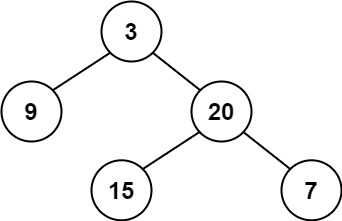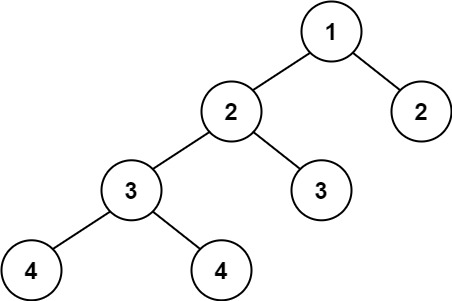1. question: 平衡二叉树(简单)
给定一个二叉树,判断它是否是高度平衡的二叉树。
本题中,一棵高度平衡二叉树定义为:
一个二叉树每个节点 的左右两个子树的高度差的绝对值不超过 1 。
来源:力扣(LeetCode)
链接:https://leetcode-cn.com/problems/balanced-binary-tree
示例 1:

1
2
| 输入:root = [3,9,20,null,null,15,7]
输出:true
|
示例 2:

1
2
| 输入:root = [1,2,2,3,3,null,null,4,4]
输出:false
|
示例 3:
提示:
1
2
| 树中的节点数在范围 [0, 5000] 内
-104 <= Node.val <= 104
|
2. answers
注意,这里将高度和深度混为一谈,均为高度的意思。
这道题最直观的方法就是求解左右子树的高度,然后判断高度差。注意,如果高度差相差小于等于1并不意味着一定是平衡二叉树,因为可能左右子树根本就不是平衡二叉树。所以还需要判断左右子树是否是平衡二叉树。
代码如下所示:
1
2
3
4
5
6
7
8
9
10
11
12
13
14
15
16
17
18
19
20
21
22
23
24
25
26
27
28
29
30
31
32
33
34
35
36
37
38
39
40
41
42
43
44
45
46
47
48
49
50
51
52
53
54
55
56
57
58
59
60
61
62
63
64
65
66
67
68
69
| public class Solution_0025 {
public static boolean isBalanced(TreeNode root) {
if(root == null) {
return true;
}
int left_depth = getDepth(root.left);
int right_depth = getDepth(root.right);
if(Math.abs(left_depth - right_depth) > 1) {
return false;
}
boolean leftResult = isBalanced(root.left);
boolean rightResult = isBalanced(root.right);
return leftResult && rightResult;
}
public static int getDepth(TreeNode root) {
if(root == null) {
return 0;
}
Queue<TreeNode> queue = new LinkedList<>();
queue.offer(root);
int length, depth = 0;
while(!queue.isEmpty()) {
length = queue.size();
depth ++;
while(length > 0) {
root = queue.poll();
if(root.left != null) {
queue.offer(root.left);
}
if(root.right != null) {
queue.offer(root.right);
}
length --;
}
}
return depth;
}
public static void main(String[] args) {
System.out.println();
TreeNode tn1 = new TreeNode(15);
TreeNode tn2 = new TreeNode(7);
TreeNode tn3 = new TreeNode(20, tn1, tn2);
TreeNode tn4 = new TreeNode(9);
TreeNode tn5 = new TreeNode(3, tn3, tn4);
System.out.println(isBalanced(tn5));
}
}
|
仔细分析一下,其实上述层序遍历求解高度的操作重复了很多次(每次递归都要层序遍历一次,而且每次递归都重复遍历了)。这其实是没必要的。怎么优化呢?
在求解深度的时候,其实就要判断该节点是否为平衡二叉树。
怎么判断呢?左右孩子节点的高度差不大于1.(如果是,那么该节点的高度就是孩子节点高度的最大值加1;如果不是,就直接返回-1,无需后续的判断了)
因此,这就形成了递归。
代码如下所示:
1
2
3
4
5
6
7
8
9
10
11
12
13
14
15
16
17
18
19
20
21
22
23
24
25
26
27
28
29
30
31
32
33
34
35
36
37
38
39
40
41
42
43
44
45
46
47
| public class Solution_0025_02 {
public static boolean isBalanced(TreeNode root) {
return getDepth(root) != -1;
}
public static int getDepth(TreeNode root) {
if(root == null) {
return 0;
}
int left = getDepth(root.left);
if(left == -1) {
return -1;
}
int right = getDepth(root.right);
if(right == -1) {
return -1;
}
if(Math.abs(left - right) > 1) {
return -1;
}
return Math.max(left, right) + 1;
}
public static void main(String[] args) {
TreeNode tn1 = new TreeNode(15);
TreeNode tn2 = new TreeNode(7);
TreeNode tn3 = new TreeNode(20, tn1, tn2);
TreeNode tn4 = new TreeNode(9);
TreeNode tn5 = new TreeNode(3, tn3, tn4);
System.out.println(isBalanced(tn5));
}
}
|
3. 备注
参考力扣(LeetCode)官网 - 全球极客挚爱的技术成长平台 (leetcode-cn.com),代码随想录 (programmercarl.com)。



